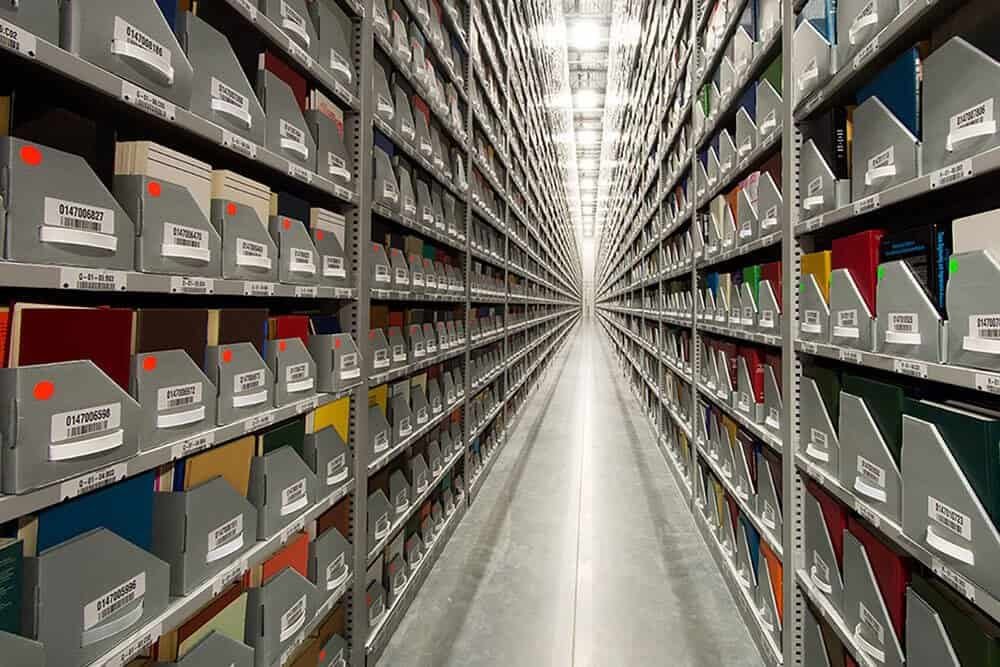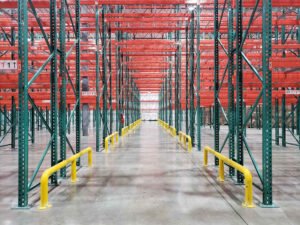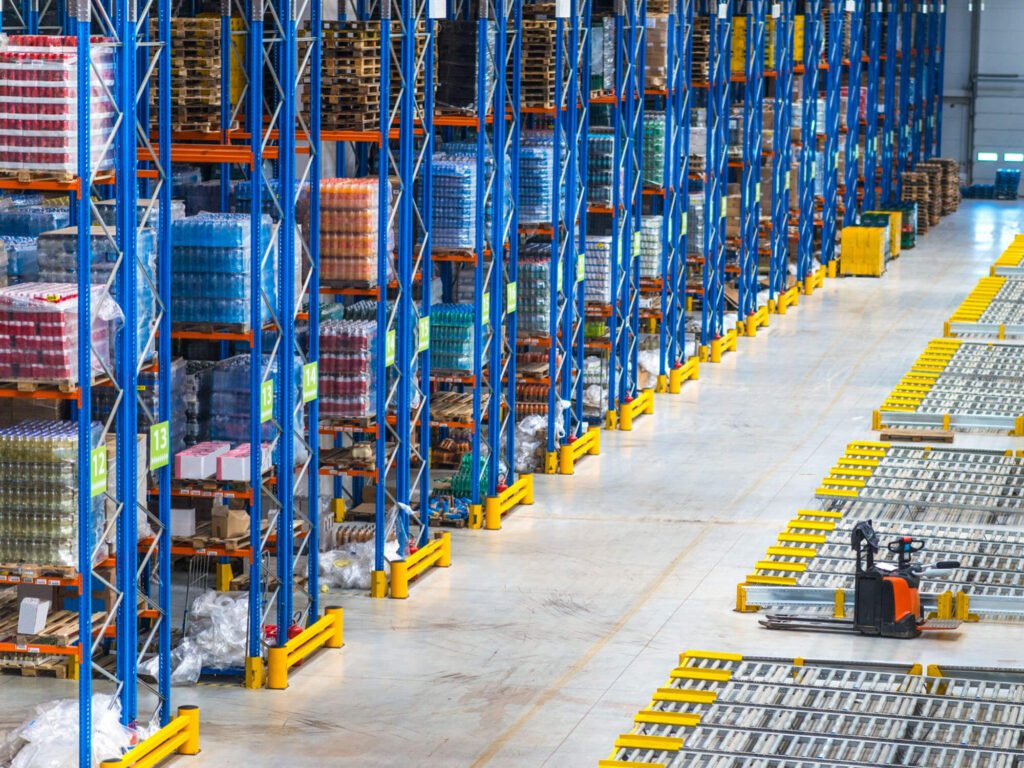Organizations seeking the optimal storage solution for their warehouses frequently encounter difficulties when selecting between industrial shelving vs industrial racking. Although both systems serve the same fundamental purpose of organizing products, they exhibit substantial differences in terms of their form, functionality, and suitability for a wide range of applications.
This detailed guide seeks to shed light on the fundamental distinctions between industrial shelving and racking systems, allowing you to make an educated selection that meets your individual requirements and budget.
By examining the many types of industrial shelving and racking systems available, as well as their benefits and drawbacks, you will be able to make an informed decision that enhances warehouse operations and helps your business grow.
What Is An Industrial Racking System?
The purpose of industrial racking systems is to accommodate the large and cumbersome items that would otherwise cause conventional shelving to tremble. Image vast pallets stacked with merchandise or even enormous machinery. Industrial racking systems are capable of confronting these titans while simultaneously ensuring the safety and organization of your warehouse.
Industrial Racking’s Unique Traits
The primary objective of industrial racking systems is to manage the challenging tasks that conventional storage is incapable of completing. Let’s investigate several distinctive characteristics that distinguish them within the warehouse:
- Built for the big and bulky: These racks are constructed from materials that are exceedingly durable, such as steel, which enables them to handle substantial quantities without any difficulty. They are ideal for the storage of pallets, large machinery, and other massive objects.
- The ultimate team players: The combination of industrial racking systems with other storage solutions, such as mezzanines, typically results in multi-level storage powerhouses that maximize vertical area usage.
- Forklift-friendly: Forget about manual labor here. These platforms are engineered to function in conjunction with forklifts or other mechanical helpers to facilitate the lifting and placement of large cargo.
- Customization is king: Just like a tailor-made suit, industrial racking can be customized to fit your unique needs. It’s like a dream come true for individuals who want extra-wide storage for huge or irregularly shaped items.
Types Of Industrial Racking
Industrial racking is available in a variety of flavors, each with its own unique capabilities:
- Selective racking: This is the most prevalent variety, providing effortless access to each pallet. It is comparable to having an individual parking space for each pallet, which is ideal for warehouses that contain a diverse array of products.
- Drive-in racking: If you’ve got a ton of homogeneous products, drive-in racking in your space-saving hero. Pallets can be loaded and unloaded directly into the racking by forklifts, thereby optimizing storage density.
- Push-back racking: Rather than advancing forward, pallets on this racking system slide back as you add new ones onto it (much like a conveyor belt for pallets). This facilitates the retrieval of the earliest items first and maintains order.
- Cantilever racking: Got long or awkward items to store? Cantilever racking has got your back. It is equipped with no front column, which enables you to effortlessly insert timbers or pipelines that are quite lengthy.
- Pallet flow racking: This storage solution is similar to push-back but with a gravity-powered variation! Pallet flow racking is suitable for high-volume selection and perishable items since pallets may quickly move from one end to another.
Advantages Of Industrial Racking
Industrial racking systems are much like the MVPs of warehouse storage. They provide a variety of advantages that can elevate your warehouse operations to the next level:
- Storage powerhouse: Industrial racking systems are adept at optimizing space, enabling the storage of significantly more items within the same area.
- Inventory made easy: Having industrial racking makes it easy to keep track of your stock. Everything is neatly put away and easy to get to, which means less time spent looking for things and more work getting done.
- Heavy-duty champ: Industrial racking is capable of accommodating massive, weighty items that would cause regular shelving to collapse. It’s the ideal solution for warehouses that are experiencing significant weight.
- Safety first: These systems are designed to be durable, ensuring the safety and security of your products and preventing accidents caused by objects toppling over.
Disadvantages Of Industrial Racking
Industrial racking is an amazing solution; however, it is not suitable for all circumstances. The following are a few considerations:
- Need for special equipment: In order to move and unload those pallets, you will require hefty apparatus, such as forklifts.
- Not ideal for manual picking: Industrial racking may impair your productivity if you regularly retrieve specific objects from the shelving.
- Initial investment: Although industrial racking may require an initial investment, it is a long-term solution that can lead to cost savings in the future.
What Is An Industrial Shelving?
Industrial shelving is comparable to the convenient toolkits in your warehouse. Industrial shelving, in contrast to the substantial industrial racking systems that require forklifts or other weighty machinery, is intended to be utilized by the individual without assistance. It is ideal for situations in which it is necessary to promptly locate and retrieve smaller items without any inconvenience.
Aside from being made of durable materials like steel, which protects your inventory from the wear and tear of a busy warehouse, industrial shelving also has innovative features like adjustable heights and extra supports, which allow you to tailor it to your specific inventory.
Industrial Shelving’s Unique Traits
Due to the following special features, which can’t be found in regular shelves, industrial shelving makes the warehouse stand out.
- Built tough: Put aside those fragile bookshelves that you possess at home. Industrial shelving is constructed from durable materials such as steel, which enables it to withstand the intense activity of a bustling warehouse without strain.
- Adaptable to your needs: These shelves aren’t simply one size fits all. You can modify their height and add a variety of fascinating extras, such as dividers or drawers, to ensure they exactly suit anything you need to store. It’s like having a personalized closet for your warehouse!
- Perfect for hands-on work: Industrial shelving is designed for simple access. There is no need for heavy equipment here; you can just reach out and get what you need. It’s like having your favorite munchies on your pantry’s front shelf!
Types Of Industrial Shelving
In the same way that there are various varieties of vehicles to suit different requirements, there are also various types of industrial storage. We will examine a few of the most frequently encountered:
- Open shelving: This is the classic, no-frills option. It’s just a bunch of open shelves supported by sturdy posts and beams. It’s perfect for items you need to access frequently or if you want to see everything at a glance.
- Closed shelving: This type has doors or cabinets to keep your stuff safe and dust-free. It’s like a vault for your valuables or those items that need a little extra protection.
- Mobile shelving: Space is tight in your warehouse? No problem! Mobile shelving is like a Transformer; it can compact itself to save space when you don’t need access, then open up to create aisles when you do. It’s the ultimate space-saving solution!
- Multi-tier shelving: Think of this as a bunk bed for your inventory. Multi-tier shelving stacks shelves vertically, so you can store way more stuff in the same footprint. It’s perfect for warehouses with ceilings and lots of stuff to store.
Advantages Of Industrial Shelving
Industrial shelving is comparable to the Swiss Army knife of warehouse storage – it is adaptable, efficient, and effectively accomplishes its objectives. Here are a few of its superpowers:
- Organization master: With industrial shelving, everything has its place. It’s like having a personal organizer for your warehouse, making it easy to find what you need and keep track of your inventory.
- Budget-friendly: Compared to other storage options, industrial shelving is a wallet-friendly option. It’s a great way to maximize your storage space without breaking the bank.
- Space saver: Industrial shelving saves important floor space by using vertical space effectively, allowing you to move around and work more freely. It’s like expanding your warehouse without constructing a larger one!
- Easy on the eyes: Industrial shelving makes everything easy to see and access, so you don’t have to waste time digging through piles of boxes. Plus, it reduces the risk of back injuries from bending and lifting heavy objects.
Disadvantages Of Industrial Shelving
The optimal solution for all circumstances is not industrial shelving, despite its remarkable appearance. Several factors must be taken into account:
- Weight limits: Compared to industrial racking, shelving can’t handle those super heavy loads. It’s best for lighter items that can be easily lifted by hand.
- Needs more space: Industrial shelving might occupy a little more floor area than racking systems since you need pathways for workers to move through and reach the shelves.
- Not for awkward items: Long or oddly shaped items might not fit well on shelves. For those, you might need a specialized racking system.
Industrial Racking Vs Industrial Shelving: Head-To-Head Comparison
After conducting a comprehensive examination of industrial shelving and racking systems individually, it is now time to compare them in order to underscore their fundamental differences and assist you in making an informed decision.
The subsequent summary table provides a concise comparison of their attributes in a side-by-side format. But if you’re interested in a more thorough understanding, please refer to the exhaustive comparison in the following sections.
| Criteria | Industrial Shelving | Industrial Racking |
|---|---|---|
| Accessibility and selectivity | Higher | Lower |
| Storage capacity and density | Low to medium | High |
| Product suitability | Smaller, lighter items | Heavy, bulky items |
| Safety considerations | Less complex safety needs | Requiring specialized equipment and training |
| Flexibility and adaptability | Higher | Lower |
| Cost-effectiveness | Lower upfront costs | Higher upfront costs |
#1: Accessibility And Selectivity
- Winner: Industrial shelving
Industrial shelving is the undisputed leader in terms of providing rapid and convenient access to individual products. You can retrieve products without the necessity of any additional equipment, thanks to its open design and highly accessible shelving. Therefore, industrial shelving is optimal for warehouses with high picking frequencies or those storing a diverse array of commodities.
On the other hand, reaching items stored at higher levels in industrial racking often requires the use of specialized material handling equipment, such as forklifts. This requirement has the potential to result in inefficiencies in the selection of individual items, particularly those that are smaller or irregularly shaped.
#2: Storage Capacity And Density
- Winner: Industrial shelving
Industrial racking systems are the more effective choice in this category. Their capacity to efficiently utilize vertical space and extend vertically enables them to accommodate a substantial volume of products within a restricted area. This is superbly beneficial for facilities with a limited footprint.
While industrial shelving offers satisfactory storage for smaller items, it falls short in terms of overall capacity and density. The stock quantity that can be stored is restricted by the horizontal construction and height constraints of racking systems (in contrast to the vertical stacking capabilities).
#3: Product Suitability
- Winner: N/A (each storage solution serves a distinct group of products).
Industrial racking systems are the ideal answer for heavy and cumbersome objects that would be too large for traditional shelving. Racking systems are designed to easily handle pallets filled with building supplies or heavy gear.
In contrast, shelving is more appropriate for objects that are lightweight and compact and can be manually moved. It’s an exceptional option for the storage of crates, containers, or individual products that do not need the heavy lifting power of a forklift.
#4: Safety Considerations
- Winner: N/A (both storage solutions demand safety considerations).
Industrial racking and shelving systems both require a high level of specialized knowledge and training, but racking systems often necessitate more attention to safety. In order to prevent accidents and preserve a secure work environment, it is essential to conduct regular inspections, distribute loads properly, and operate forklifts safely.
Although shelving systems are generally safer due to their lower height and manual access, they still necessitate compliance with safety regulations, including secure installation and appropriate weight distribution.
#5: Flexibility And Adaptability
- Winner: Industrial shelving
For those who require a storage solution that can readily adapt to changing needs, industrial shelving is a more flexible option. Its modular design enables the uncomplicated reconfiguration and adjustment of shelf heights to accommodate varying product sizes or fluctuating inventory levels.
Despite its customization ability, industrial racking is typically less adaptable once it has been installed. The process of modifying or expanding a racking system can be more intricate and time-consuming than altering shelving.
#6: Cost-Effectiveness
- Winner: Industrial shelving
Industrial shelving is the more cost-effective option when preliminary costs are taken into account. It is a simple and straightforward solution that does not require specialized apparatus or complex installation procedures.
Industrial racking may require a more substantial initial investment due to its heavy-duty construction and potential need for forklifts. Nonetheless, its higher storage density and potential for enhanced effectiveness may make it more cost-effective in the long run.
Choosing The Right Type Of Shelf Or Rack For Your Needs
It might be difficult to choose the best storage option for your warehouse. However, by completing the five stages outlined below, you will be able to make an educated conclusion.
Step 1: Analyzing Your Products
First, you should do an inventory study. Think about the goods you want to store and their type, size, weight, and any special handling needs.
Industrial racking is the superior option for those who predominantly handle substantial or larger items, as it boasts a superior load capacity and robust construction. In contrast, industrial shelving may be the optimal choice if your inventory primarily comprises smaller, lighter products that are easy to handle manually.
Step 2: Evaluating Your Space And Accessibility Needs
Next, conduct an exhaustive assessment of the available space in your warehouse and your accessibility requirements. Consider factors such as the dimensions of your storage areas, ceiling height, aisle widths, and the frequency with which you need to access specific items.
Industrial shelving is the superior option if space is restricted and you require frequent access to individual items. This is due to its open design and the simplicity of manual selection.
Nevertheless, industrial racking systems, especially drive-in or push-back racking, may be more efficient if you prioritize maximizing storage density and predominantly store palletized products.
Step 3: Determining Your Storage Capacity And Future Growth
Take into account your current and prospective storage needs. Estimate the quantity of products that require storage at present and anticipate any potential future growth or expansion.
Industrial racking is more suited for businesses with ambitious development plans or those with large inventories, as it typically has a higher storage capacity than shelving. Yet, shelving may be a more cost-effective alternative if you have a restricted budget and only need stowage for a smaller number of items.
Step 4: Factoring In Your Budget
When selecting between industrial shelving and racking, budget is a critical factor. Shelving is generally more affordable upfront, but it might not be the most cost-effective long-term solution if your storage needs are extensive or involve heavy items.
Racking systems demand a bigger initial investment, but they can provide long-term savings by increasing storage density, improving efficiency, and lowering labor expenses.
Step 5: Prioritizing Safety And Compliance
Safety should always be the primary concern, regardless of whether you opt for shelving or storage. Guarantee that the selected system adheres to pertinent safety regulations and standards.
Be mindful that industrial racking frequently necessitates specialized tools and training to ensure its safe operation. Conversely, while shelving systems are generally safer due to their lower height and manual access, they still necessitate adherence to safety guidelines and proper installation.
Lracking: Your Go-To For Industrial Shelving And Racking
Looking to level up your warehouse storage game? Lracking is at your service. They are a premier provider of industrial shelving and racking solutions, ensuring that you will find the ideal solution for your warehouse, regardless of the type of material you’re storing, from large pallets to small, delicate components.
All of Lracking’s products are designed to ensure the safety of all of your possessions, optimize your space, and improve efficiency. They have everything from sturdy pallet racks and flexible shelving systems to those space-saving mezzanines and multi-tier racking configurations.
But what really distinguishes Lracking is their commitment to make your warehouse visions a reality. Their experienced staff will work closely with you to understand your specific needs and provide a customized storage solution that is best suited to your inventory and available space.
Conclusion
So, what is the judgment in the great duel between industrial shelving and industrial racking? It’s like deciding between a toolbox and a truck. Both are quite useful, yet they are most successfully used for different objectives. Racking is the best option for heavy-duty storage and space efficiency, whilst shelving is best suited for smaller, lighter objects that need simple access.
The key is to figure out your warehouse’s genuine requirements. Take into account the quantity of space available, the nature of the products you are storing, your budget, and the frequency with which you require access to your inventory. Once you have a good handle on those factors, choosing the right system becomes a whole lot easier.Should you still feel like you’re lost in the storage jungle, don’t be afraid to ask for help! You can get help from companies like Lracking to figure out what kind of storage you need and whether industrial shelving, custom shelving, or a mix of the two is best.




